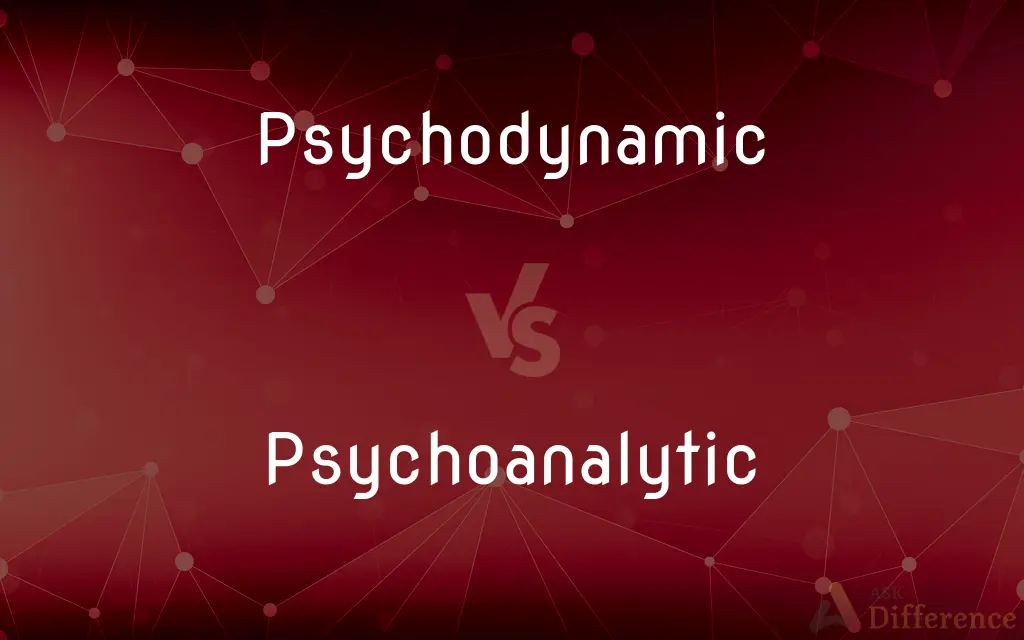Psychodynamic vs. Psychoanalytic — What's the Difference?
By Tayyaba Rehman — Updated on October 30, 2023
Psychodynamic pertains to the interplay of unconscious and conscious emotions and motivations; Psychoanalytic refers specifically to Freudian therapy and theories about the unconscious mind.

Difference Between Psychodynamic and Psychoanalytic
Table of Contents
ADVERTISEMENT
Key Differences
Psychodynamic is a broad term that encompasses various psychological theories and therapies rooted in the idea that human behavior is influenced by unconscious drives and desires. On the other hand, Psychoanalytic specifically refers to the theories and therapeutic methods developed by Sigmund Freud.
Psychodynamic approaches not only draw inspiration from Freud but also integrate concepts from other thinkers, making it more encompassing. Conversely, Psychoanalytic remains more closely tied to the original Freudian principles, emphasizing the role of early childhood experiences and dream analysis.
While all Psychoanalytic approaches can be considered Psychodynamic, not all Psychodynamic approaches are Psychoanalytic. This distinction is crucial for understanding the nuances between them.
Both approaches prioritize understanding the underlying unconscious forces that influence behavior, but the Psychoanalytic method has a more defined set of principles and techniques rooted in Freudian theory.
Compare with Definitions
Psychodynamic
Psychodynamic emphasizes the role of unconscious processes in shaping behavior.
The Psychodynamic model believes that many of our motivations arise from hidden desires.
ADVERTISEMENT
Psychoanalytic
Psychoanalytic focuses on the role of unconscious desires, especially as they relate to early childhood.
Freud's Psychoanalytic theory emphasized the Oedipus complex as a crucial developmental stage.
Psychodynamic
Psychodynamic refers to the interplay of unconscious and conscious drives and emotions.
The therapist took a Psychodynamic approach to understand the patient's deep-seated fears.
Psychoanalytic
Psychoanalytic therapy aims to explore repressed memories and desires.
Through Psychoanalytic sessions, she began to uncover forgotten memories from her past.
Psychodynamic
Psychodynamic pertains to the dynamic relation between the conscious and unconscious processes.
Psychodynamic theories suggest that unresolved past traumas can impact current behavior.
Psychoanalytic
Psychoanalytic pertains to the clinical method of treating psychological disorders through introspection and interpretation.
The therapist used a Psychoanalytic approach to decode the symbolic meaning behind his recurring nightmares.
Psychodynamic
Psychodynamic theories consider psychological forces and their interplay in influencing behavior.
Psychodynamic perspectives often delve into childhood experiences and their lasting impact.
Psychoanalytic
Psychoanalytic emphasizes the importance of the unconscious mind in shaping behavior and thought.
The Psychoanalytic viewpoint holds that many of our actions are driven by unconscious desires.
Psychodynamic
Psychodynamic is a therapeutic approach that aims to bring unconscious material to the conscious mind.
Through Psychodynamic therapy, he began to recognize patterns in his behavior.
Psychoanalytic
Psychoanalytic pertains to the theories and therapeutic methods developed by Sigmund Freud.
The Psychoanalytic approach often involves analyzing dreams to uncover hidden meanings.
Psychodynamic
(used with a sing. or pl. verb) The interaction of various conscious and unconscious mental or emotional processes, especially as they influence personality, behavior, and attitudes.
Psychoanalytic
The method of psychological therapy originated by Sigmund Freud and dominant throughout most of the 20th century, in which free association, dream interpretation, and analysis of resistance and transference are used to explore repressed or unconscious impulses, anxieties, and internal conflicts, in order to free psychic energy for mature love and work.
Psychodynamic
(used with a sing. verb) The study of personality and behavior in terms of such processes.
Psychoanalytic
Psychotherapy incorporating this method and theory.
Psychodynamic
Of or pertaining to psychodynamics, the dynamic interplay between forces that govern human behavior, or the study of this
Psychoanalytic
(psychoanalysis) Of or relating to psychoanalysis.
Psychoanalytic
Of or relating to or incorporating the methods and theory of psychiatric treatment originated by Sigmund Freud;
Freud's psychoanalytical theories
Psychoanalytic treatment
Common Curiosities
What is the Psychodynamic approach?
Psychodynamic refers to the study of unconscious and conscious drives and emotions influencing behavior.
Who is associated with the Psychoanalytic theory?
Sigmund Freud is the primary figure associated with Psychoanalytic theory.
What does Psychoanalytic mean?
Psychoanalytic specifically pertains to the theories and therapeutic methods developed by Sigmund Freud.
Are all Psychoanalytic approaches Psychodynamic?
Yes, all Psychoanalytic approaches are Psychodynamic, but the converse isn't true.
Are repressed memories a focus in both approaches?
Yes, both approaches consider the role of unconscious processes, including repressed memories.
Which approach is broader in scope?
The Psychodynamic approach is broader, encompassing a variety of theories, while Psychoanalytic is specifically Freudian.
Why is dream analysis prominent in the Psychoanalytic method?
Because Freud believed dreams offer a window into the unconscious mind and its desires.
Why are childhood experiences emphasized in Psychoanalytic theory?
Freud believed that early childhood experiences play a pivotal role in shaping adult behavior and desires.
Does the Psychodynamic approach strictly adhere to Freudian principles?
No, while it may draw from Freudian concepts, Psychodynamic can integrate ideas from other thinkers too.
Can a therapist be both Psychodynamic and Psychoanalytic?
Yes, a therapist can utilize both, but being Psychoanalytic means adhering more strictly to Freudian principles.
Is the Psychodynamic approach limited to therapy?
No, it encompasses various psychological theories, not just therapeutic methods.
Can someone without formal training practice a Psychodynamic approach?
While some principles can be understood, formal training ensures proper therapeutic application and understanding.
How do the two approaches view human behavior?
Both view behavior as influenced by unconscious factors, but Psychoanalytic places more emphasis on specific Freudian concepts.
Can these approaches be used in conjunction with other therapies?
Absolutely! Many therapists use a blend of Psychodynamic, Psychoanalytic, and other therapeutic modalities.
Are there any modern modifications to Psychoanalytic therapy?
Yes, while the core remains Freudian, many therapists integrate contemporary findings and techniques.
Share Your Discovery

Previous Comparison
Keyboard vs. Synthesizer
Next Comparison
Crisis vs. DisasterAuthor Spotlight
Written by
Tayyaba RehmanTayyaba Rehman is a distinguished writer, currently serving as a primary contributor to askdifference.com. As a researcher in semantics and etymology, Tayyaba's passion for the complexity of languages and their distinctions has found a perfect home on the platform. Tayyaba delves into the intricacies of language, distinguishing between commonly confused words and phrases, thereby providing clarity for readers worldwide.















































